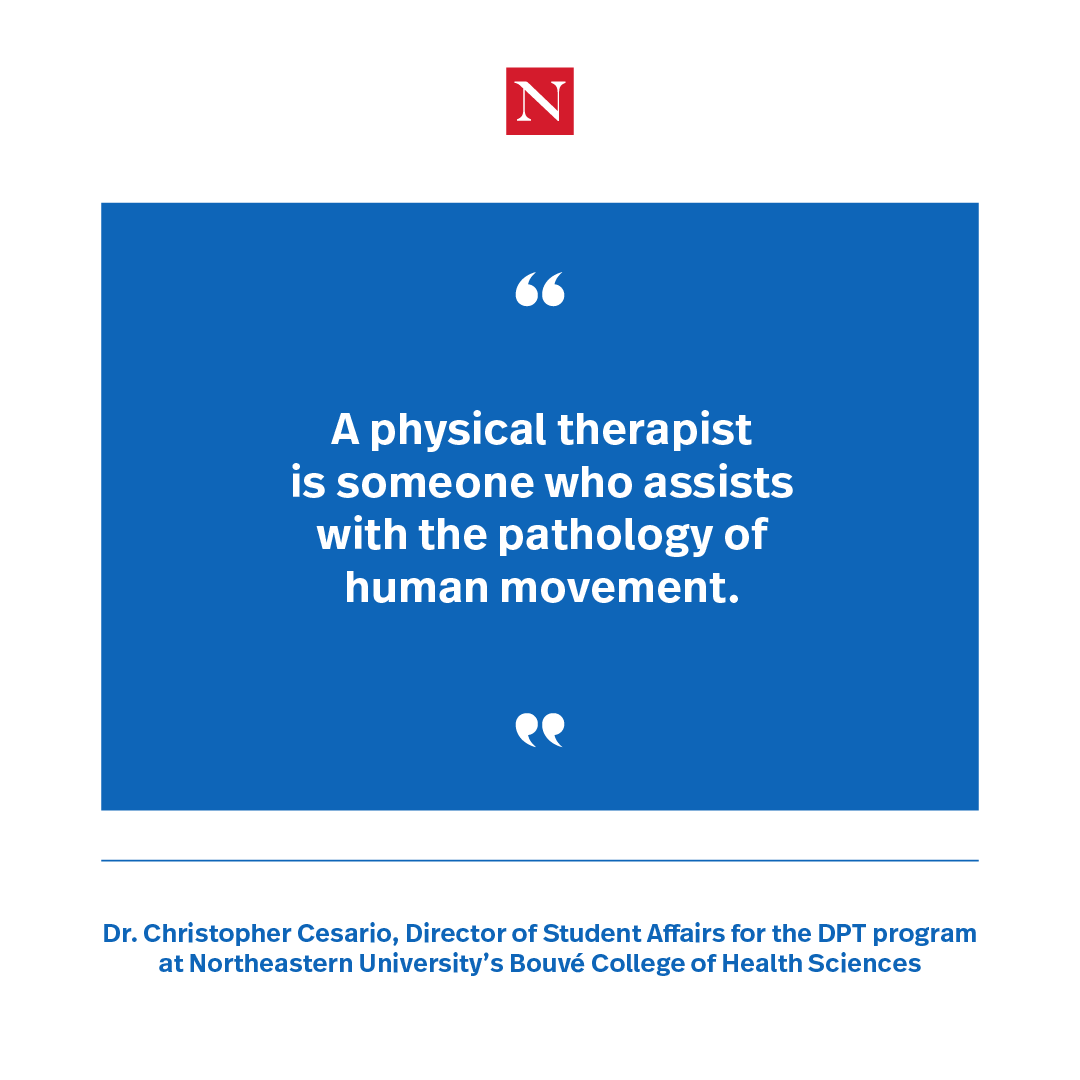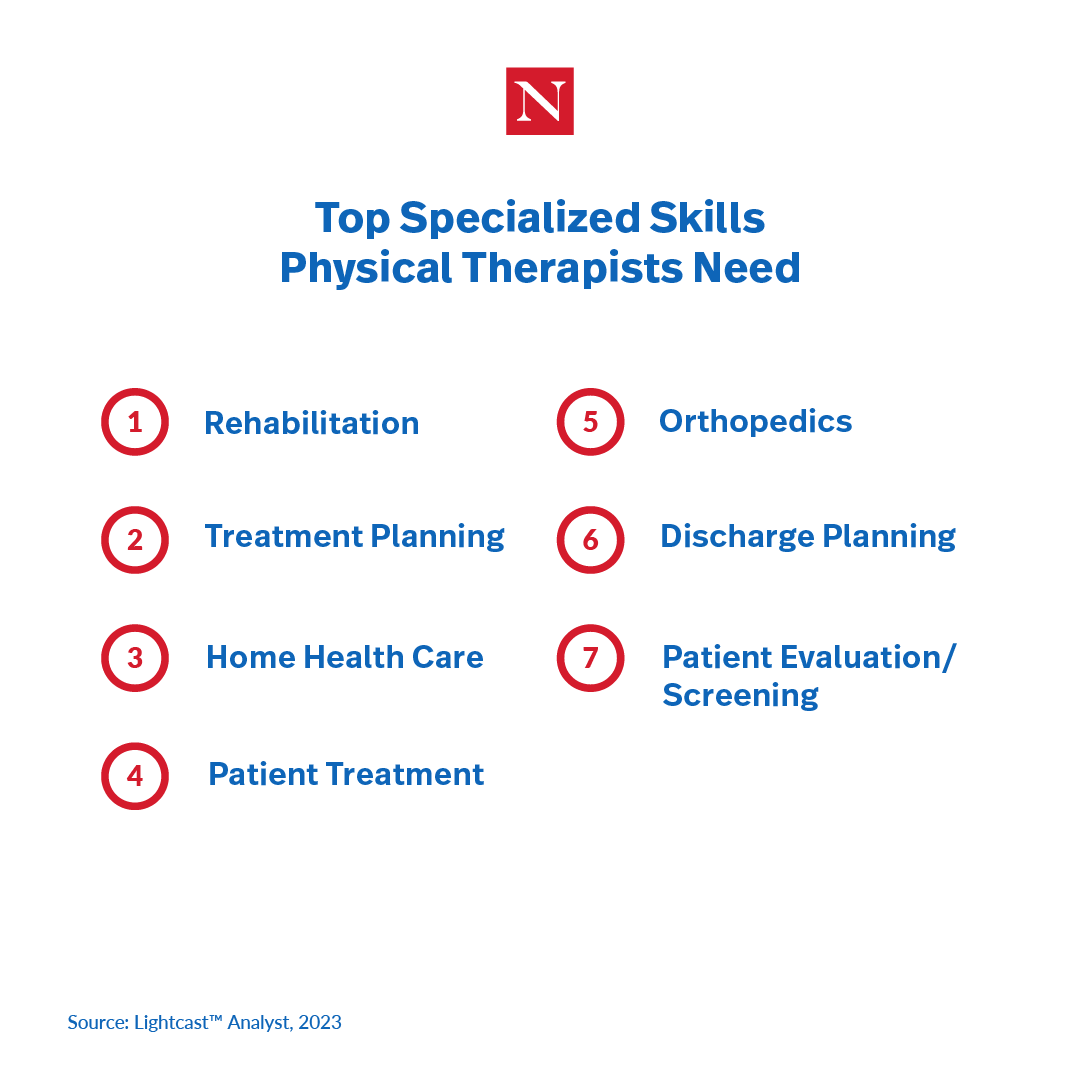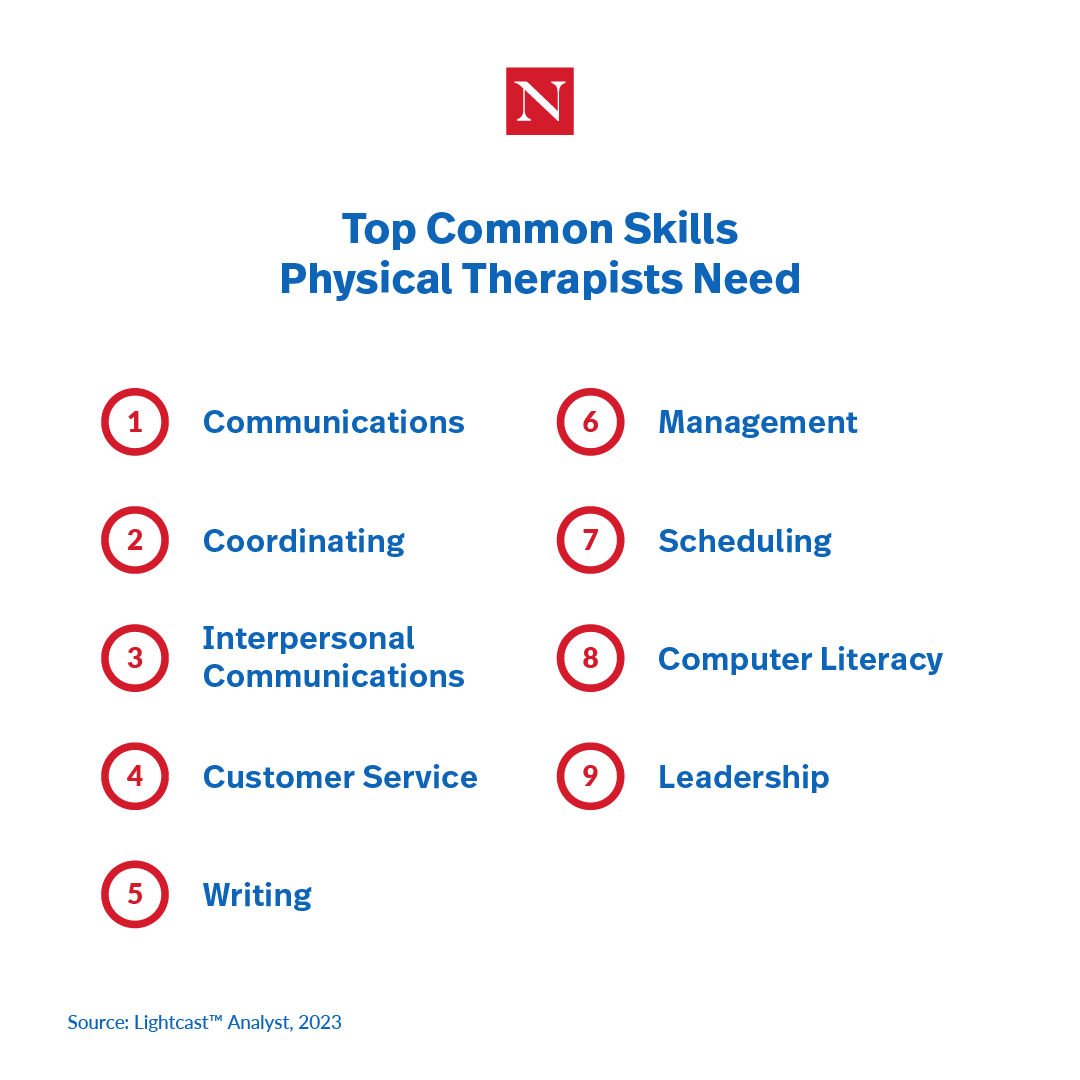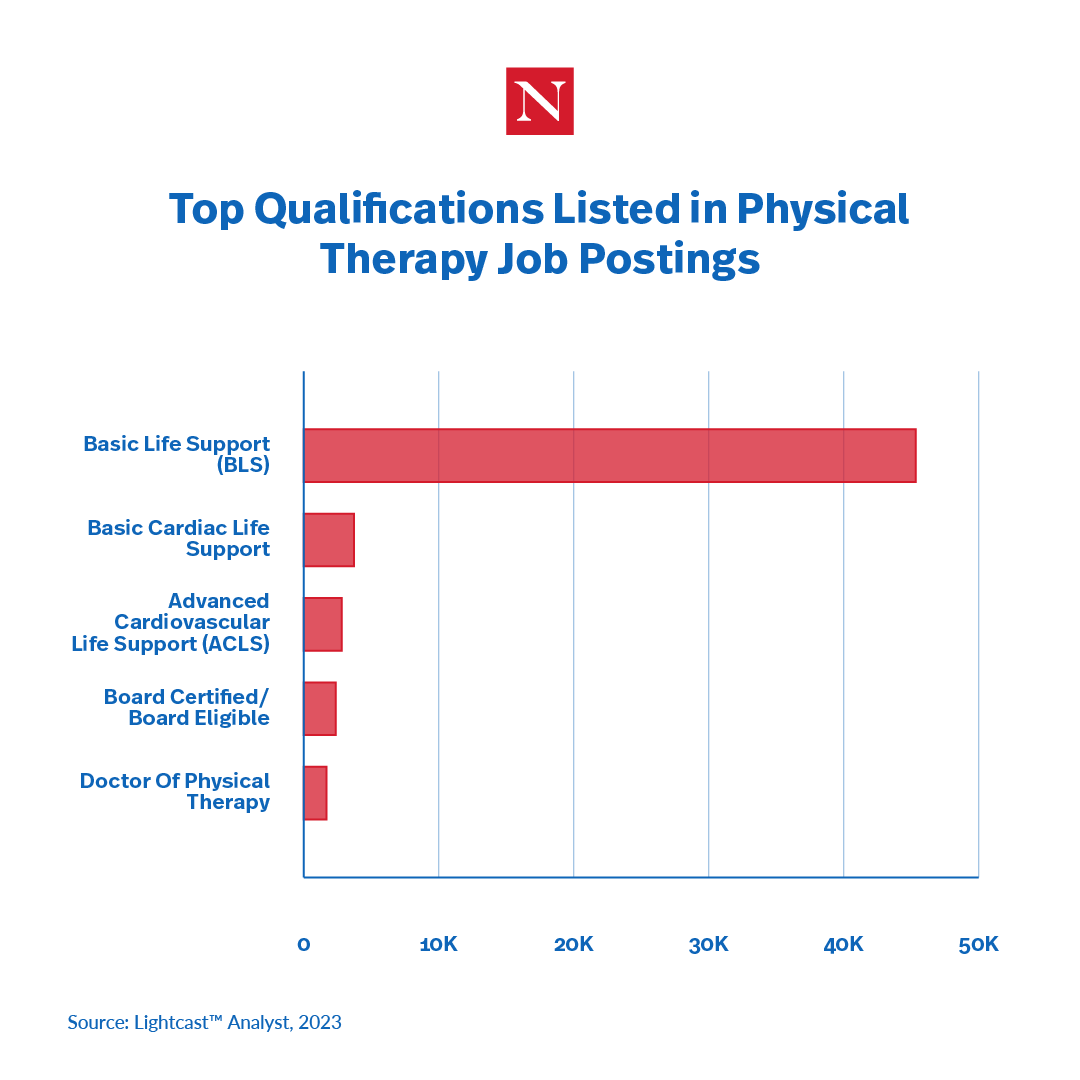If you or your loved ones have ever recovered from a serious injury or illness, you’ve likely consulted with a physical therapist (PT) for healing and guidance. Physical therapists help people regain strength and reach their rehabilitation goals, providing much-needed support at often a difficult time in patients’ lives. In fact, observing the great work they do may have sparked your personal interest in how to become a physical therapist.
Physical therapy is a broad field that overlaps with nearly every type of healthcare practice. Whether you enjoy helping people recuperate or teaching them how to manage pain, therapeutic careers offer countless ways to make a difference in the lives of others.
Here’s an overview of what physical therapists do, how to become one, and the essential steps to becoming a physical therapist.
What Does a Physical Therapist Do?
“A physical therapist is someone who assists with the pathology of human movement,” says Dr. Christopher Cesario, Associate Clinical Professor and Director of Student Affairs for the Doctor of Physical Therapy (DPT) program at Northeastern University’s Bouvé College of Health Sciences. Patients treated by PTs are typically coping with impaired mobility or a loss of muscular strength with diverse medical needs ranging from children with developmental disorders to seniors rebuilding motor functions after a stroke. Injuries from accidents, work, and sports are also common issues.

Physical therapists know how to “look at orthopedic, neurological, and cardiovascular issues and help navigate those problems,” says Cesario. Working alongside other healthcare providers, they diagnose physical impairments and create treatment plans around therapeutic exercise to help patients either recover from trauma or adapt to mobility challenges. In addition to having strong clinical experience, PTs must be compassionate and supportive of patients while using their observation and judgment skills to evaluate their needs.
How To Become a Physical Therapist
If you’re a current student or planning to go back to school, you may wonder how long it takes to become a physical therapist. Although physical therapy has a clearly outlined path to licensure, the timeline depends on your professional background, where you are in your education, and whether you can commit to full-time enrollment.
Download Our Free Guide to Physical Therapy
Everything you need to know about becoming a physical therapist
Here’s what to expect when working toward becoming a physical therapist if you have no prior background in this field.
1. Obtain a Relevant Undergraduate Degree
Physical therapist education occurs at the doctoral level, so you must earn an undergraduate degree before you can pursue this career path. While many physical therapy schools require a degree in a related field, having relevant education also increases your competitiveness in programs that don’t require it. Luckily, physical therapy encompasses many topics across the science, health, and fitness disciplines, offering various flexible options.
Acceptable majors vary by program, but some examples include:
- Kinesiology
- Health Sciences
- Biology
- Physiology
- Exercise Science
Many of the foundational education courses provided in these degree programs can often help accelerate the process of becoming a physical therapist. This is largely because these prerequisite courses are needed in order to advance your education.
2. Determine What Type of Job You Want
By determining the type of job you want in advance, you can make better choices about your educational path and get more value out of a physical therapy program. Physical therapists work with people of all ages who have diverse health goals. As a result, prospective PTs have the opportunity to explore a range of specialties and healthcare environments before graduating.
“I think it’s worth the time to do some observation,” says Cesario. “The general public’s perception of physical therapy is that it’s all orthopedics. And when students find out that there’s physical therapy in a hospital or other settings, it’s kind of enlightening to know that there’s other options.”
With this in mind, try to consider the type of patients you want to work with, conditions you want to treat, and workplace settings you prefer. Some of the healthcare facilities that employ physical therapists are:
- Pediatric
- Neurological
- Sports
- Oncology
- Geriatric
- Cardiovascular
- And more
3. Obtain a Doctor of Physical Therapy Degree
Earning a Doctor of Physical Therapy (DPT) degree is required to become a physical therapist. While any accredited DPT programs provide the knowledge and clinical experience needed to succeed in this field, it’s important to consider each program’s prerequisite courses. For example, many programs are tailored to students who already have substantial undergraduate credits in the health sciences. In addition, some schools require GRE exam scores, while others do not. As you compare your options, make sure the curriculum is in line with your personal and professional goals, and you can satisfy the admission criteria.
At the same time, keep an open mind throughout your education. Look for physical therapy programs that offer in-depth insight into different disciplines through research labs, simulated clinics, or mentorships. A diversified education, like Bouvé’s Post Baccalaureate Doctor of Physical Therapy degree program, will give you the comprehensive knowledge to evaluate complex medical histories and provide high-quality patient care in a variety of settings.
“We’ve had a trend in recent years where students come in and they’ve already self-identified that they want to be a pediatric, orthopedic, etc. therapist,” says Cesario. “Even if you’re coming into your education with the mentality that you want to do this kind of physical therapy, you still need to understand how the whole body works.”
4. Develop Relevant Skills
Focus on skill-building throughout your education since these competencies are essential for long-term career mobility. According to our analysis of job postings data, the top specialized skills for this career include:
- Rehabilitation
- Treatment planning
- Home health care
- Patient treatment
- Orthopedics
- Discharge planning
- Patient screening/evaluation

Cesario also believes patient education is another essential skill prospective PTs should develop during their education. “Patient education is something that physical therapists do well and often on a regular basis.”
In addition to technical skills, Cesario urges prospective PTs to work on their soft skills since this is inherently a “service profession.” Being able to effectively communicate, schedule, and educate patients are essential to becoming a better care provider. According to our analysis of job postings data, the top common skills required in this field include:
- Communications
- Coordinating
- Interpersonal communications
- Customer service
- Writing
- Management
- Scheduling
- Computer literacy
- Leadership

5. Obtain Additional Relevant Qualifications
It’s important to note that completing the required physical therapy education alone doesn’t allow you to immediately start practicing. So, how do you become a physical therapist after earning a DPT degree?
First, it’s essential to understand your state’s licensing requirements for physical therapists. If you plan on moving post-graduation, ensure you check these requirements in the state you hope to work in. Gaining licensure is achieved by passing the National Physical Therapy Examination (NPTE). Many institutions offer assistance throughout this process, but the level of support offered to students to prepare for the NPTE is another factor you should consider when choosing a DPT program.
In addition to these requirements, there are a number of valuable credentials you can pursue to increase your marketability in today’s job market. Here are the top qualifications physical therapists obtain, according to our analysis of job postings data.
Foundational Healthcare Certifications
Having the ability to stabilize someone experiencing a life-threatening emergency is critical for anyone who provides patient care. While these certifications aren’t specific to the field of physical therapy, it’s recommended prospective PTs obtain certification in:
- Basic Life Support (BLS)
- Basic Cardiac Life Support
- Advanced Cardiovascular Life Support (ACLS)

Board Certified/Board Eligible
Getting certified in a clinical specialty advances your knowledge and verifies your expertise. “Board certification is an important qualification to seek out,” says Cesario. “There are a number of opportunities for students to prepare for their boards, including self-preparation and residency programs.” Check out the American Physical Therapy Association (APTA) website to explore the ten specialty certifications they nationally recognize.
6. Build Your Professional Network
Networking before and after you become a PT can make a significant difference in your professional success. As a doctoral student, mentors and peers will be your best resources for developing your skills, researching clinical specialties, finding job opportunities, and understanding the various challenges physical therapists face on a daily basis.
Building relationships with fellow students is also helpful for sharing knowledge and evaluating healthcare from many different perspectives. As you move further into your career, your peers often continue to be a sounding board. Physical therapy involves a lot of observation and adjustment, and other PTs can offer advice and creative solutions based on their diverse experiences on the job. In addition, networking with physicians and other healthcare providers is a time-tested way to get ongoing referrals, especially if you decide to start your own private practice.
7. Gain Professional Experience
Differentiating yourself is challenging when you first start your career, so drawing on past professional experience from reputable sources is essential. Seek out opportunities that show your commitment to learning and growth, whether it’s from internships, mentorships, shadowing, research, or simulation labs.
Choosing the right school is also important because the best DPT programs provide access to critical resources for clinical experience. Physical therapy degree programs that incorporate more experiential learning opportunities in clinical practice will help you feel prepared for real-world environments and demonstrate your proficiency to prospective employers.
Start Your Career in Physical Therapy
If you’re ready to become a physical therapist, enrolling in Northeastern’s Bouvé College of Health Sciences’ Post Baccalaureate Doctor of Physical Therapy degree program is a great way to jumpstart your new career. The faculty consists of board-certified experts with years of experience in clinical specialties—most of them currently practicing therapists with a pulse on today’s industry trends.
Physical therapy students have ongoing opportunities to network and put their skills into action through internships and co-ops. Northeastern University employs an experiential learning model that centers the curriculum in real-world applications, continually encouraging students to think strategically about patient care. To learn more about what the DPT program has to offer, you can contact an admissions counselor and even connect with current students to find out if this degree is right for you.







Related Articles
4 Pressing Global Health Problems We Face Today
Global Health Careers: How Can I Make a Difference?
Compliance Specialists: Who They Are and What They Earn